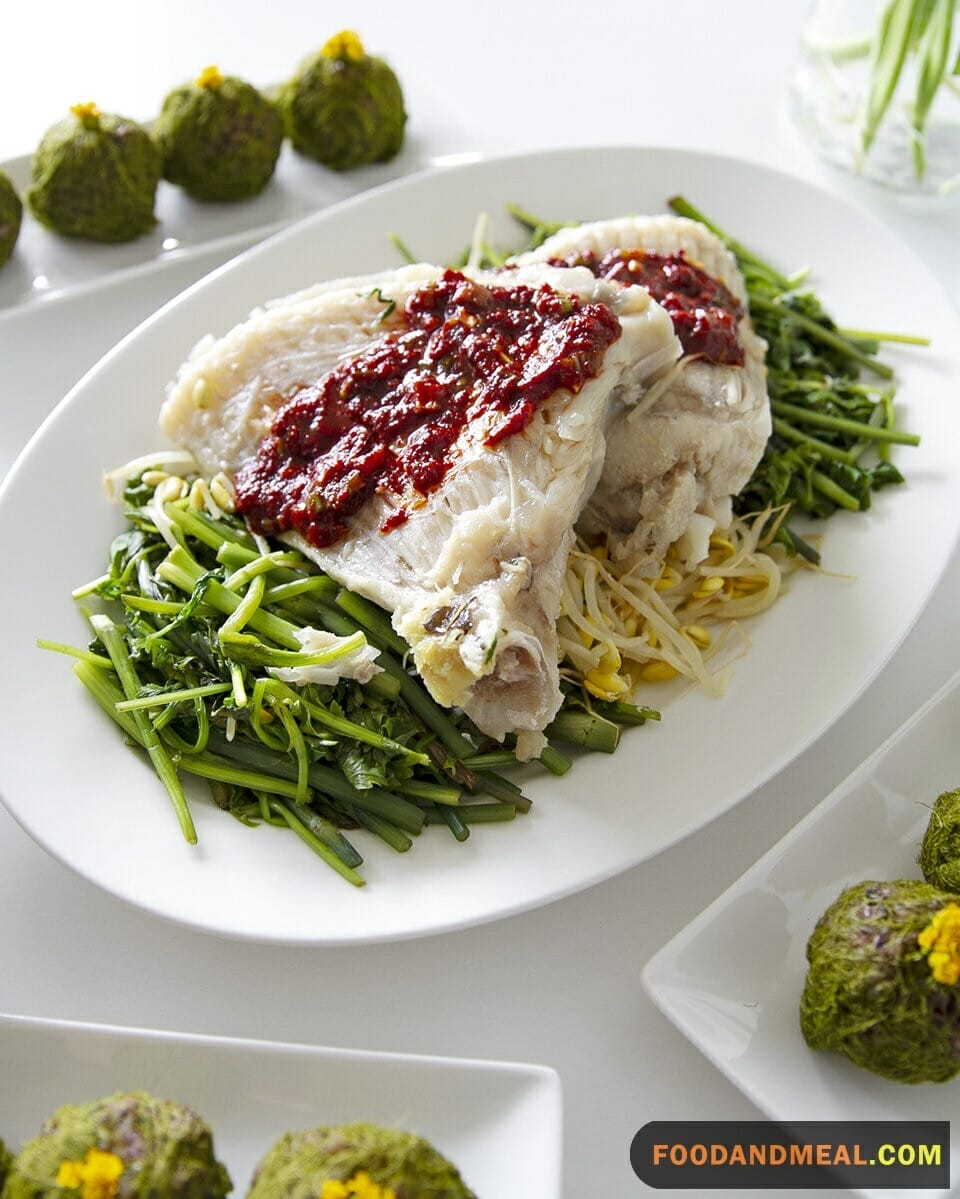As a chef at Food And Meal, I’m always looking to expand my culinary horizons and introduce our readers to new and exciting dishes. Lately I’ve become fascinated with steamed skate fish after reading about this unique preparation method used in Korean cuisine. Given my passion for seafood and Asian flavors, I knew I had to try making this recipe at home.
The delicate, mild flavor of skate makes it the perfect canvas for letting the other ingredients shine. And steaming maintains all the healthful moisture and nutrients without overpowering the fish’s subtle notes. I love how the soybean paste mixture creates the most savory, umami-rich broth as it simmers away. Dancing ribbons of egg in the steaming liquid look so inviting, beckoning me to take a spoonful of the luscious sauce.
Beyond its wonderful flavors, this steamed skate speaks to my adventurous spirit in the kitchen. I pride myself on never shying away from an unfamiliar ingredient or technique at Food And Meal. My culinary mantra is that with an open mind and a dash of courage, any home cook can whip up restaurant-worthy dishes. I can’t wait to chronicle my first attempt at this Korean specialty, and I hope it inspires our readers to challenge themselves in the kitchen as well! Now it’s time to gather my ingredients and steam up some skate.

Steamed Skate Fish Korean Recipe

STEAMED SKATE FISH
Ingredients
- Salt
- Freshly ground black pepper
- 2 large skate wings, skinned, filleted, and rinsed
- 2 tablespoons good-quality sake (or rice cooking wine)
- 2 tablespoons toasted sesame oil
- 3 eggs, lightly beaten
- 1 scallion, thinly sliced on the bias, for garnish
- Korean chile thread or gochugaru, for garnish
Instructions
- Sprinkle salt and pepper on both sides of the skate wings.
- Put the skate wings in a steamer set over boiling water, cover, and steam for about 10 minutes.
- Pour the sake and sesame oil over fish and cover again. Steam for an additional 5 to 10 minutes (depending on thickness), until the fish is cooked through (is opaque and flakes when poked with the tip of a sharp knife).
- Meanwhile, cook the eggs in a nonstick skillet into a thin, flat omelet, and then slice it into thin strips.
- Serve the fish hot, garnished with the egg strips, scallion, and chili thread.
Video
Notes
Nutrition
© Food And Meal
This website provides approximate nutrition information for convenience and as a courtesy only. Nutrition data is gathered primarily from the Spoonacular Database, whenever available, or otherwise other online calculators.
Oven-Baked Steamed Skate Fish Korean Recipe
To prepare oven-steamed skate fish, begin by preheating the oven to 350°F. Clean, fillet, and marinate the skate fish. Create a steaming effect by placing a raised oven-proof rack in a baking dish with water. Arrange marinated fish fillets on the rack without overlapping. Seal the dish tightly with aluminum foil to trap steam. Bake in the preheated oven for 25-30 minutes until the fish is tender and easily flakes with a fork. Carefully remove the foil, garnish as per the original recipe, and serve the skate fish hot.
Cooking Tips: Steamed Skate Fish Korean Recipe

First and foremost, finding fresh skate at the market will be paramount. I plan to gently poke the flesh to ensure it springs back, showing its freshness. Once home, I’ll pat the fish dry, as excess moisture can hinder steaming.
When it comes to flavoring, I’m eager to experiment with my marinade—perhaps I’ll add extra ginger and garlic for some zing. But I’ll be careful not to overpower the skate’s delicate notes. And I’ll remember that a light hand with salt goes a long way to amplify flavors.
As for the steaming method, the key will be avoiding overcooking. Skate cooks quickly, so I may set a timer to ensure perfect doneness. I’m hopeful my first skate dish will be a success I can share with Food And Meal readers soon. Though even if it’s not picture-perfect, this journey promises to be a rewarding one.
Serving Suggestions: Steamed Skate Fish Korean Recipe

Pair it with Soy Sauce Eggs for a delightful blend of flavors or indulge in the richness of Soy Dipping Sauce to elevate the umami profile. For a more substantial meal, combine the delicate fish with Vegetarian Gyoza or Teriyaki Salmon, creating a Japanese-inspired seafood feast. Introduce a refreshing contrast with Vegetable Maki rolls or opt for a seafood extravaganza by adding Wok Fried Crab to the menu. For a comforting meal, enjoy the steamed skate fish alongside a bowl of Tonkotsu Ramen, or add a bold and smoky flavor with Blackened Salmon. These serving ideas promise to bring a variety of tastes and textures to complement the subtle and tender nature of the steamed skate fish, making your dining experience both diverse and enjoyable.
FAQs: Steamed Skate Fish Korean Recipe

- Is skate fish good to eat? Yes, skate fish is considered a delicacy and is enjoyed for its delicate, slightly sweet flavor. It has a unique texture, making it a sought-after choice in various cuisines.
- Is skate a cheap fish? Skate is often more affordable compared to some other seafood options. Its reasonable cost makes it an accessible choice for those looking to enjoy a delicious seafood meal without breaking the bank.
- What kind of fish is a skate fish? Skate fish is a type of cartilaginous fish, known for its flat body and wing-like pectoral fins. It is not a true bony fish but is closely related to rays and sharks.
- How to prepare skate fish? Preparing skate fish can be done by cleaning, filleting, and marinating it according to your preferred recipe. One popular method is steaming, ensuring the delicate flavors are preserved. The fish can be served with various accompaniments to enhance the dining experience.
- What is Skate Fish? Skate fish is a unique type of seafood, known for its flat body and wing-like pectoral fins. It boasts a delicate, slightly sweet flavor, with a texture that’s a cross between rays and sharks. Popular in Korean cuisine, skate is often enjoyed fermented or steamed.
- I’m not familiar with Korean spices. Can I substitute them? Absolutely! While traditional Korean spices give this dish its authentic flavor, you can always adapt based on what you have. For example, if you don’t have gochugaru (Korean chili flakes), you can substitute with other chili flakes or powder but adjust the amount to your heat preference. However, for a genuine taste, I recommend sourcing the original spices.
- Can I use frozen skate fish for this recipe? Yes, you can. If using frozen skate, ensure it’s fully thawed before steaming. While fresh skate fish will always provide the best flavor and texture, a well-thawed, high-quality frozen skate can also yield delicious results.
- How do I store leftovers? Steamed skate fish is best enjoyed fresh. However, if you have leftovers, store them in an airtight container in the refrigerator for up to 2 days. Reheat gently to avoid overcooking the fish.
- I’m having trouble finding skate fish. Can I use another type of fish? While skate fish offers a unique flavor and texture, you can substitute with other flat fishes like flounder or halibut. The steaming time might vary based on the thickness of the fish, so keep an eye out and adjust accordingly.
Conclusion
As I reflect on my journey cooking steamed skate fish for the first time, I’m thrilled to share the lessons I’ve learned with Food And Meal readers. Though the process came with its challenges, the rewards of creating this delicate dish made it all worthwhile.
Most importantly, I now understand the care required when handling skate to keep it fresh, as well as the restraint needed when seasoning to let its subtle flavors shine. While my first attempt may not have achieved the texture and doneness I was aiming for, each step brought valuable insights.
After gathering more tips from experienced skate fish aficionados, I’m excited to revisit this recipe. Perhaps I’ll adjust the steaming time or experiment with adding aromatics to the broth. Though even if perfection remains elusive, I’m grateful for the chance to expand my culinary horizons with Food And Meal. Please stay tuned for more flavor adventures!
Hi! I'm Nazia of ‘Nazia Cooks’, a self-taught baker and cook residing in Chennai. Rooted in the rich South Indian culinary landscape, my palate has expanded to embrace global flavors. I revel in crafting fusion dishes, melding traditions to birth unique tastes.



